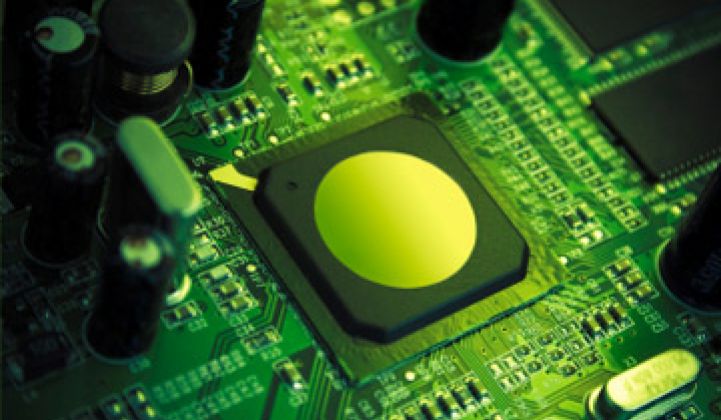This ARM thing is getting serious.
Nvidia, one of the world's leading companies in graphic chips and a company that has thirsted to compete more directly with Intel for more than a decade, unveiled "Project Denver" today: an effort to build processors for servers, supercomputers and desktops based around a core from England's ARM.
Chips designed by ARM dominate the cell phone market and have already tied up a good portion of the smart meter market. Analysts have talked about ARM moving into servers and desktops for years, but a serious push has only begun recently.
ARM chips consume far less power than standard Intel processors, and even less than the low-powered Intel Atom chip. The problem, however, has been that they didn't have the same computing heft to tackle complex assignments.
Technology and history, however, have begun to help in that regard. ARM cores have become increasingly complex and Moore's Law has allowed ARM developers to add more transistors to their processors. (ARM just designs the basic core -- its licensees then elaborate on the core and produce chips under their own names. See this story on how ARM became a monopoly by being nice. Weird.)
At the same time, computing has become more dumb. Ten years ago, servers and server chips were built to handle complex tasks: weather modeling, economic analysis, etc. Now, most servers get bought to pop up web pages or run repetitive authentication tasks. Imagine getting a PhD and only being able to find employment in a used book store. That's the server market today.
Another boon: some of the large server consumers like Google design their own servers with help from Taiwanese contract manufacturers. This lessens Intel's influence with the brand-name server makers.
Datacenters only consume about 2 percent of the world's electricity, but that figure continues to grow. A bigger problem, however, is that large datacenter owners now fear they can't expand their businesses within the power that's available to them. The only choice they have to grow is to become more efficient. Desperation is the reason green IT is expected to be a boom market.
Last year, a startup called Calxeda, formerly Smooth-Stone, announced plans to produce an ARM-based chip that would run servers. Texas Instruments and ARM itself are investors, along with firms like Battery Ventures.
Soon after, Freescale, the multibillion-dollar chip group that came out of Motorola, announced similar plans. So has Marvell. Nvidia helps add momentum. Of course, the announcements from the big names are bad news for Calxeda, which for its part claims it is ahead in terms of several design components.
Nividia will invest too. CEO Jen-Hsun Hwang, an immigrant whose first experience in America was a rough Kentucky school where he cleaned toilets, has longed to scrap with Intel for years. This represents one of his best opportunities.
Does this mean the demise of Intel? Au contraire, says Andrew Feldman, CEO of SeaMicro. That company has created a dense server with 512 Atom processors. It uses one-fourth the power and one-fourth the space of conventional servers. The networking fabric inside SeaMicro's server (the secret sauce here) also lets it go into deeper sleep states to save more energy and utilize computer assets more efficiently.
"We're selling a box that behaves like 40 servers," he said in a recent interview. (More coming up from SeaMicro soon.). Feldman claims that the average person (hmm -- maybe a Google user) uses one of his company's servers every day.
SeaMicro can use ARM chips, but why not go with Atom chips? They are cheap. They are here. And they run the usual software. Plus, at two watts, Atom chips aren't burning up the inside of computers.
The track record is not too hot, either. Several companies -- Montalvo Systems, Rise, Transmeta, Cyrix, IDT, National Semiconductor -- have tried to take on Intel with cheap and/or low-powered processors. Many raised millions in VC funds and lined up partnerships with high-profile companies like IBM. Most died horrible deaths. Advanced Micro Devices, which operates under a design license from Intel, has survived, but barely at times. Since it was founded in 1969, AMD has actually lost more money than it has made.
The manufacturing prowess, aggressive product roadmap and even the sales deals Intel can put together are formidable. One executive at an Intel competitor told me once how he signed a small deal with a Taiwanese motherboard maker. Intel execs were on a plane soon afterwards, and the deal collapsed.
It looks like this is shaping up to be a good ARM wrestling match.



